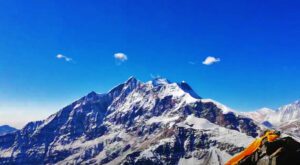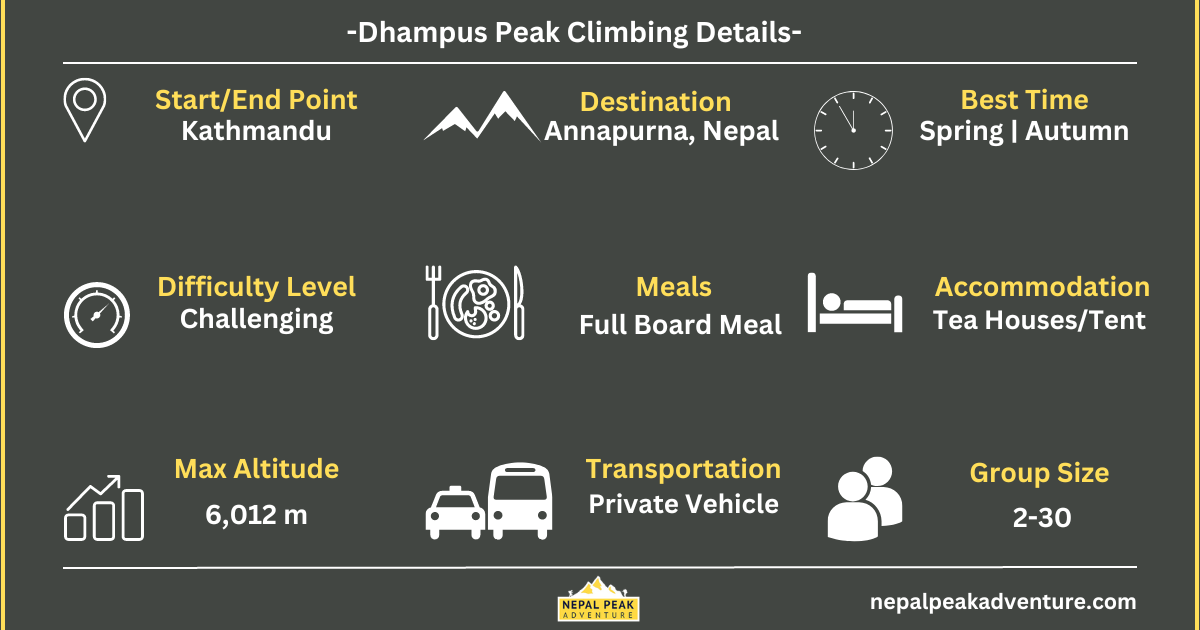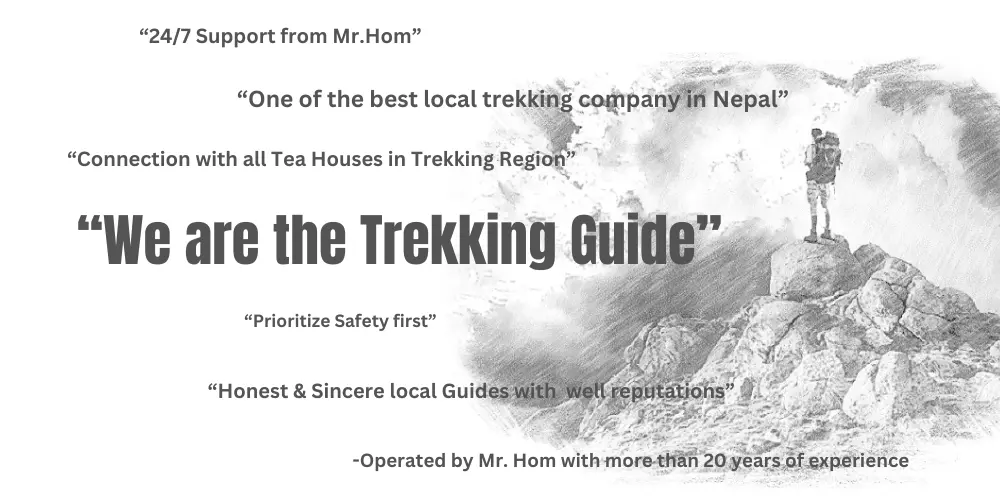Dhampus Peak Climbing is delightfully a medium-level trekking summit in Annapurna Nepal with an elevation of 6,012 meters above sea level and one of the top 5 beginner peaks in Nepal.
Dhampus Peak's difficulty level is PD+/AD- which means slightly difficult, however, it still requires some mountaineering experience & good physical fitness to have a safe climbing experience. None other than less, the stunning views of the Annapurna & Dhaulagiri ranges are worth the effort.
Here are some Dhampus Peak highlights:
- Best peak climbing for starters in the Annapurna Region with breathtaking views of the Himalayas.
- Budget-friendly climbing peak which only costs $2,900 & includes all services.
- Opportunity to experience the unique culture & lifestyle of local communities i.e. Gurung & Magars.
- Pass through a conservation area enriched with wildlife and nature & a chance to see rare species.
- Chance to build up teamwork, experience in using gears, and develop camaraderie and friendship.
- Summit Dhampus Peak (6,012m) & earn lifetime achievement.
Overall, climbing Dhampus Peak is both challenging and rewarding that takes only 14 days to complete.
Cost Includes for Dhampus Peak Climbing:
Typically, the Dhampus Peak Climbing takes 14 Days and costs around $2,900. However, there are group discounts and the services included and excluded are as follows.
- Tribhuvan Airport pick-up via private vehicle upon arrival in Kathmandu.
- Welcome Dinner at a Reputable Restaurant with a live Nepali Cultural Program.
- Tourist standard Accommodation in Kathmandu on the basis of twin sharing including Breakfast | B&B Basis.
- All Ground transportation services included that are required for the trek.
- Teahouse and Tent Accommodation during the Trekking & Climbing of Dhampus Peak.
- Full Board Meals during both Trekking and Climbing | BLD (Vegan or Veg foods can be served upon request)
- 3 Times Tea or Coffee per day during trekking
- Expenses of Climbing Crews for Dhampus Peak
- Trekking & Climbing Guide | Government-certified, fluent English speaker, first aid and eco-trained
- Assistant Guides | We provide an assistant guide as per the group size to support you wherever necessary
- Porters during Trekking & Climbing | We provide porters as per the necessity to carry your stuff.
- All Necessary Climbing Permit Fee for Dhampus Peak
- All federal and local taxes as applicable
- Cold resistance Down Jacket and sleeping Bag (upon request)
- A duffle Bag (for the expedition purpose only) and a T-shirt (as a souvenir)
- Trekking Map
- Certificate of Climbing Completion
- Group medical Kit Box
- The arrangement of Emergency Helicopter evacuation service as per your travel insurance company
- Farewell Dinner at a reputable Restaurant | (Usually Nepali Cuisine)
- Final departure transfer via private vehicle
Cost Exclusion in Dhampus Peak Climbing
- Nepal Visa fee
- International flight to Kathmandu and a return ticket from Nepal.
- Your meal at Kathmandu besides welcome dinner, farewell dinner, and breakfast
- The entire cost of beverages (except hot drinks mentioned in the inclusion list), mineral water, and beer.
- Travel insurance (must include Helicopter evacuation)
- Tipping to the guide, porter, and all climbing crew
- Climbing equipment of personal nature
- Items not included in the inclusion list come under your expenses.
Permits for Dhampus Peak Climb:
You will need an Annapurna Conservation Area permit and a Dhampus Peak Climbing permit to summit Dhampus Peak.
However, to get the permit, there is a certain process that needs to be done which is as follows:
- You cannot obtain permits on your own as a government-registered trekking agency is required for the trek
- A passport photocopy, a Nepalese Visa photocopy, a passport-sized photo, & proof of travel insurance is necessary.
- ACAP & TIMS card needs to be obtained
- A climbing guide is mandatory to climb Dhampus Peak
Once the process is complete, the trekking agency will then submit your permit application to NMA(Nepal Mountaineering Association) & obtain your climbing permit.
It takes about two weeks to complete all the preparation for permits and the expenses for Dhampus Peak Permit will be around $350 per person for a group of up to four climbers.
If you are climbing in a group of more than four people like six people then the Dhampus peak permit needs an additional $40 per person for example (i.e., $350 + $40 + $40).
14 Days Outline Itinerary of Dhampus Peak Climbing
This 14-day Dhampus Peak outline itinerary begins from Kathmandu to Pokhara, Pokhara to Tatopani, Ghasa, Larjung, Marpha, Yak Kharka, & summit to Dhampus.
Here is the outline itinerary:
- Day 01: Arrival in Kathmandu & Transfer to Hotel via Private Vehicle
(Room on the basis of twin sharing | B&B Basis) - Day 02: Sightseeing in Kathmandu & Trek Preparation
(Explore Thamel for money exchange, gears, & other) - Day 03: Drive to Pokhara City | 6-7 hours Drive
(Flight to Pokhara is optional with a certain charge) - Day 04: Drive from Pokhara to Tatopani | 4-5 hours Drive
(Popular Hot Spring located here) - Day 05: Trek to Ghasa (2,010m alt) |5-6 hrs trek
(Small beautiful village located on the bank of kali Gandaki) - Day 06: Ghasa to Larjung trek (2,550m) | 5-6 hrs
(Traditional Gurung Houses with traditional architecture)
- Day 07: Trek to Marpha (2,670m) | 4-5 hrs
(Beautiful and quiet village that offers a unique blend of nature) - Day 08: Trek to Yak Kharka (3,900m) | 56 hrs
(High-altitude grazing ground of Yaks) - Day 09: Trek from Yak Kharka to Dhampus/Thapa Pass (5,244m) | 6-7 hrs
- Day 10: Summit Dhampus/Thapa Peak (6,012m) and Return to Kalopani (3,930m) | 8-9 hrs
(Dhampus Peak Climbing | The moment to achieve the goal) - Day 11: Trek back to Tatopani (2,530m) | 5-6 hrs
(Hot Spring for relaxation) - Day 12: Drive to Pokhara | 6-7 hrs
- Day 13: Drive Back to Kathmandu
(Usually farewell dinner at a reputable restaurant) - Day 14: Departure Day
Detailed Itinerary:
Day 01: Arrival in Kathmandu & Transfer to Hotel via Private Vehicle
Upon your arrival in Kathmandu, our representative will meet you at the airport & guide you to your hotel located in Thamel.
During leisure time, you can meet our guide for your trek or you can roam the Thamel area and exchange money, buy gear, rent gear or eat Nepali cuisine.
Day 02: Trip Preparation & Sightseeing in Kathmandu
All the paperwork needed for the Dhampus Peak Climbing will be completed today. So, during your leisure time, sightseeing in Kathmandu will be arranged for you.
You will visit Pashupatinath Temple, Bouddhanath Stupa, Swayambhunath Stupa, Durbar Square & other popular places in Kathmandu.
Day 03: Drive from Kathmandu to Pokhara | 6-7 hours
After breakfast, we will have a long drive to Pokhara City which can take up to 6 hours. We will have lunch on the way.
Pokhara is a beautiful tourist city that offers a vibrant nightlife scene, friendly locals, natural beauty, delicious cuisine, and relaxation.
Dinner & overnight stay at the hotel located in Phewa Lakeside.
Day 04: Drive from Pokhara to Tatopani | 4-5 hours Drive
Today we will head to Tatopani via Beni after breakfast in the hotel. The 4-5 hours drive from Pokhara to Tatopani offers a scenic view while passing through the cultivated fields & small villages.
The special about Tatopani is the hot spring which is the best way to release fatigue. Dinner & overnight stay in Tatopani.
Day 05: Trek to Ghasa (2,010m alt) |5-6 hrs trek
Start the day with breakfast & head to Ghasa which will take 5-6 hours approximately. The trek passes through the charming village and offers impressive landscapes.
In the evening, spend time exploring the village & interacting with the locals. Overnight stay in Ghasa
Day 06: Trek from Ghasa to Larjung | 5-6 hrs
Ghasa to Larjung will take approximately 5-6 hours of walking. During the trek, you will pass through small local villages & have a picturesque of Annapurna Ranges.
Dinner & Overnight stay in Larjung.
Day 07: Trek to Marpha (2,670m) | 4-5 hrs
After breakfast, the trail takes you through the dense forest & past traditional villages to reach Mapha village. The whole trek takes about 4-5 hours while having short breaks from time to time.
Marpha is well known for its delicious juicy apples, traditional architecture, monasteries, & warm hospitality.
This place is a must-visit place in Annapurna Region. Overnight stay in Marpha village.
Day 08: Trek to Yak Kharka (3,900m) | 5-6 hrs
Yak Kharka is another popular place after Marpha in Annapurna Region which takes 5-6 hours to reach. This place is home to several species including Himalayan Tar, Blue Sheep, & snow leopards.
Similarly, the landscape is dotted with Yaks grazing making it a picturesque & tranquil spot. Accommodation & meals are also good in this village as all the tea houses or lodges are built using local materials.
Overnight stay in Yak Kharka.
Day 09: Trek from Yak Kharka to Dhampus/Thapa Pass (5,244m) | 6-7 hrs
One of the big days today as you will pass Dhampus/Thapa Pass at 5,244m altitude. Walking slowly & drinking enough fluids is the main key to reaching Dhampus/Thapa Pass. Overnight stay.
Day 10: Summit Dhampus/Thapa Peak (6,012m) and Return to Kalopani (3,930m) | 8-9 hrs
Today is the big day. We will start our trek very early in the morning. Everything will have been prepared by our team already. We will go slow taking breaks as the climb is steep. Finally, we will make it to the top.
You will spectate the majestic views of Dhaulagiri, Nilgiri, Sita Chuchura, Tukuche peak, Thorong Peak, Mukut Himal, Annapurna South, and many more from te top.
We will then return back to Kalopani for an overnight stay.
Day 11: Trek back to Tatopani (2,530m) | 5-6 hrs
From Kalopani, it is just a 5-6 hours of walk to reach Tatopani, all way down to the hot spring. Get yourself to relax in the hot spring to release all the fatigue.
Overnight stay in Tatopani
Day 12: Drive to Pokhara | 6-7 hours
After breakfast, we will now prepare to head back to Pokhara via vehicle. Enjoy your time in Lakeside. Overnight stay in Lakeside Pokhara
Day 13: Drive Back to Kathmandu
Back to Kathmandu again from Pokhara which will take 5-6 hours. Breakfast in the hotel, lunch on the way, and dinner at the Kathmandu hotel.
Day 14: Departure Day
Our representative will transfer you to the Tribhuvan International Airport according to your schedule.
Dhampus Peak Climbing Useful Information:
Here is some useful information about Dhampus Peak.
How difficult is climbing Dhampus Peak?
Climbing Dhampus Peak is relatively easy compared to other peaks in Annapurna Region or Everest Region. With an elevation of 6,012m, Dhampus Peak Climbing is considered the starter peak for climbers who are seeking to start their peak climbing activities.
However, climbers should not underestimate climbing Dhampus Peak as it requires the same mountaineering skills.
Proper preparation is very important and precautions must be taken to ensure a safe & successful climb.
It is also recommended to hire an experienced guide to get the necessary support and guidance during the climb.
Equipment Required for Dhampus Peak Climbing:
Climbing Dhampus Peak requires basic mountaineering equipment, including climbing gear, clothing, footwear, & other miscellaneous.
It is recommended to wear clothes in layers as it makes it easy to change clothes according to the conditions of the weather.
You will only carry your needed stuff in your backpack while other gear or equipment will be carried by a porter while trekking. Only when climbing Dhampus Peak, you will carry your climbing gear with you.
All equipment, such as base camp tents, climbing ropes, ice hammers, snow bars, and ice screws will be provided by Nepal Peak Adventure.
Here are the lists of climbing gear that you will need:
- Climbing Boots
- Crampons with 12 points
- Ice Axe that fits your height & preference
- Helmet
- Harness that should be adjustable for different layers of clothing
- Ropes
- Carabiners & Slings
- Ascender & Descender suitable for peak climbing
- Prusik Cord with a diameter of 6-7mm
- Tent
- Sleeping Bag
Head Wear: Headwear for both trekking and climbing.
- Climbing Helmet: A good climber always wears a good quality helmet to protect the head from icefalls, falls, rockfalls, or any other things that can give serious injuries.
- Warm Woolen Cap
- Face Mask
- 100% UV Protection glasses
- Mountaineering Sunglasses / Ski Spectacles
- Balaclava for Mountaineering
Lower Body:
- Hiking/Mountaineering Pants | Water Proof & Durable
- Insulated Pants
- Moisture-Wicking Long Underwear
- Gaiters | Leg Gaiters
- Climbing Harness
- Crampons
- Socks | Moisture-Wicking & Warm
- Sandals while staying in Lodge or Tea Houses
- Mountaineering Boots | Full Boot
- -60°C Resistance Down Jacket
Upper Body:
- Fleece Jacket | Insulated Jacket | Softshell Jacket
- Poluprophine
- Gloves | Expedition Shell Gloves, Woolen Gloves, Fleece Gloves
- Expedition Down Windcheater with Hood
- Shorts
Useful Gears:
- Sleeping Bag for Mountaineering
- Ice Axe | Light
- Harness
- Carabiners
- Climbing Sling
- Walker/Pole | Adjustable
- Crampons
- Rappel Device
- Climbing Boots | Plastic Mountain Boots ( Crampon compatible)
Pack: A Duffel Bag will be provided by the company upon request
- Cosmetic | Sunscreen, Moisturiser, Lip Balm
- Headlamp
- Water Bootle | Hydration Tablet | Plastic Mug
- Water Purification Tablets
- Towels | Toiletries
- Required Documents
- Games | Cards
As for the trekking gear, you can get a checklist from us. The most important thing to consider when packing is to make the backpack light and use the right gear.
Travel Insurance for Dhampus Peak Climbing:
Travel Insurance that covers up to 6,000m is compulsory for Dhampus Peak climbing which can be done online too.
When choosing the insurance for Dhampus peak, do check if it covers up to 6,000m altitude, coverage for Baggage & Personal Belongings in case of theft, loss, or damages, personal liability, & trip cancellation or interruption.
It is also important to disclose any pre-existing medical conditions you have to the insurance provider as well as us when asked. Companies like World Nomads make insurance for trekking.
Weather in Dhampus Peak:
Weather in Dhampus peak is challenging & unpredictable due to the high altitude however in the right season, the weather in Dhamus Peak will be best for climbing.
During Spring & Autumn seasons, most of the climbers visit Dhampus Peak as the weather is considered favorable with clear blue skies.
Overall, climbers should be prepared for a wide range of weather conditions when planning a Dhampus Peak Climbing trip. You can check out "Best time to trek in Nepal" for more detailed information.
How much Money to Carry for Dhampus Peak Climbing & Trekking?
All the accommodations & meals will be provided by Nepal Peak Adventure in Dhampus Peak Climbing. For other expenses such as charging a battery, drinking, ordering extra items, hot shower & other personal expenses will be paid by yourself.
Usually, NPR 1,500 cash is estimated to be a daily budget for Dhampus Peak Climbing.
What is the Best Time to visit Dhampus Peak?
As Tea Houses & Lodges are open throughout the year, the best time to visit Dhampus Peak is still in Spring & Autumn seasons.
However, it is still recommended to expect a sudden change in weather even in Spring & Autumn seasons. Hope you have prepared a flexible date when planning the peak climbing.
Why Dhampus Peak Climbing?
Well, there are a number of reasons but the main reason is to see the spectacular views of the mountains from the summit. You will see over thirty different peaks between Annapurna and Dhaulagiri with a close view of Tukuche(6,920m) and Dhaulagiri(8,163m). In addition to this, you can also explore the villages along the route and some of the monasteries around this area as well. It is a great way to experience the local culture and discover some of the local histories of this area too.
The Dhampus peak climbing is one of the easiest trekking peaks in Nepal and is physically less demanding. So, beginners with little trekking knowledge and experience can also easily climb this peak. The peak can be climbed throughout the year however Spring (March-May) and Autumn (Oct-Dec) would be the ideal choice. Also, you can opt for the Dhaulagiri Circuit trek which is another spectacular trekking experience via French pass and Thapa pass.











